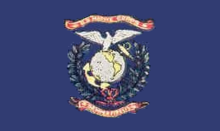| This article is part of a series on the |
| History of the United States |
|---|
 |

 The flag of the United States Marine Corps from 1914 to 1939
The flag of the United States Marine Corps from 1914 to 1939
The history of the United States Marine Corps (USMC) begins with the founding of the Continental Marines on 10 November 1775 to conduct ship-to-ship fighting, provide shipboard security and discipline enforcement, and assist in landing forces. Its mission evolved with changing military doctrine and foreign policy of the United States. Owing to the availability of Marine forces at sea, the United States Marine Corps has served in nearly every conflict in United States history. It attained prominence when its theories and practice of amphibious warfare proved prescient, and ultimately formed a cornerstone of U.S. strategy in the Pacific Theater of World War II. By the early 20th century, the Marine Corps would become one of the dominant theorists and practitioners of amphibious warfare. Its ability to rapidly respond on short notice to expeditionary crises has made and continues to make it an important tool for U.S. foreign policy.[1]
In February 1776, the Continental Marines embarked on their maiden expedition.[2] The Continental Marines were disbanded at the end of the war, along with the Continental Navy.[3] In preparation for the Quasi-War with France, Congress created the United States Navy and the Marine Corps. The Marines' most famous action of this period occurred in the First Barbary War (1801–1805) against the Barbary pirates. In the Mexican–American War (1846–1848), the Marines made their famed assault on Chapultepec Palace, which overlooked Mexico City, their first major expeditionary venture. In the 1850s, the Marines would see service in Panama, and in Asia. During the U.S. Civil War (1861–1865) the Marine Corps played only a minor role after their participation in the Union defeat at the first battle of First Bull Run/Manassas.[4] Their most important task was blockade duty and other ship-board battles, but they were mobilized for a handful of operations as the war progressed. The remainder of the 19th century would be a period of declining strength and introspection about the mission of the Marine Corps. Under Commandant Jacob Zeilin's term (1864–1876), many Marine customs and traditions took shape. During the Spanish–American War (1898), Marines would lead U.S. forces ashore in the Philippines, Cuba, and Puerto Rico, demonstrating their readiness for deployment. Between 1900 and 1916, the Marine Corps continued its record of participation in foreign expeditions, especially in the Caribbean and Central and South America, which included Panama, Cuba, Veracruz, Haiti, Santo Domingo, and Nicaragua.
In World War I, battle-tested, veteran Marines served a central role in the United States' entry into the conflict. Between the world wars, the Marine Corps was headed by Major General John A. Lejeune, another popular commandant. In World War II, the Marines played a central role, under Admiral Nimitz, in the Pacific War, participating in nearly every significant battle. The Corps also saw its peak growth as it expanded from two brigades to two corps with six divisions, and five air wings with 132 squadrons. During the Battle of Iwo Jima, photographer Joe Rosenthal took the famous photo Raising of the Flag on Iwo Jima of five Marines and one naval corpsman raising a U.S. flag on Mount Suribachi. The Korean War (1950–1953) saw the 1st Provisional Marine Brigade holding the line at the Battle of Pusan Perimeter, where Marine helicopters (VMO-6 flying the HO3S1 helicopter) made their combat debut. The Marines also played an important role in the Vietnam War at battles such as Da Nang, Huế, and Khe Sanh. The Marines operated in the northern I Corps regions of South Vietnam and fought both a constant guerilla war against the Viet Cong and an off and on conventional war against North Vietnamese Army regulars. Marines went to Beirut during the 1982 Lebanon War on 24 August. On 23 October 1983, the Marine barracks in Beirut was bombed, causing the highest peacetime losses to the Corps in its history. Marines were also responsible for liberating Kuwait during the Gulf War (1990–1991), as the Army made an attack to the west directly into Iraq.[5] The I Marine Expeditionary Force had a strength of 92,990, making Operation Desert Storm the largest Marine Corps operation in history.
- ^ Dalton, John Howard; Jeremy Michael Boorda; Carl Epting Mundy Jr. (9 November 1994). "Forward... From the Sea". Navy.mil. United States Department of the Navy. Archived from the original on 12 June 1997.
- ^ Cite error: The named reference
Hoffmanwas invoked but never defined (see the help page). - ^ University, Sam Houston State. "Page Not Found: 404 – Sam Houston State University". SHSU Online. Archived from the original on 8 January 2015. Retrieved 16 November 2014.
{{cite web}}: Cite uses generic title (help) - ^ "The Marine Battalion at the Battle of Bull Run: Emending the Record". mca-marines.org. 1 February 2002. Archived from the original on 21 December 2017. Retrieved 15 November 2018.
- ^ Quinn II, Major John T. (1996). U.S. Marines in the Persian Gulf, 1990–1991. Washington D.C.: United States Marine Corps Historical Division. PCN 19000316300. Retrieved 12 December 2008.